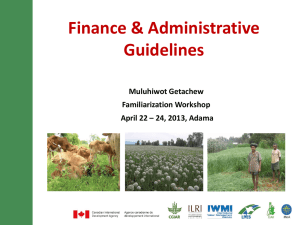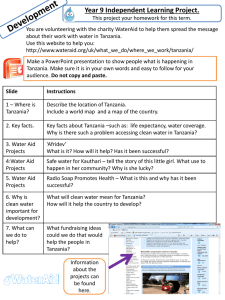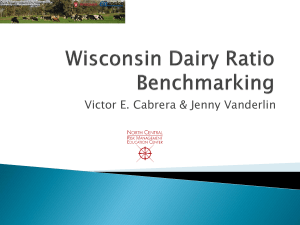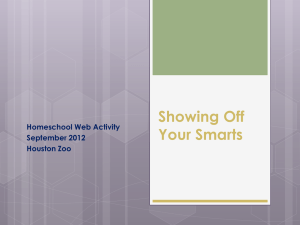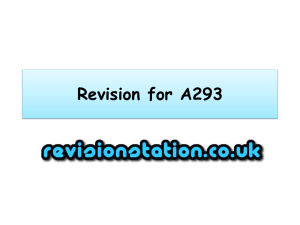Tanzania Smallholder Dairy VC Update - 10 Feb 2014
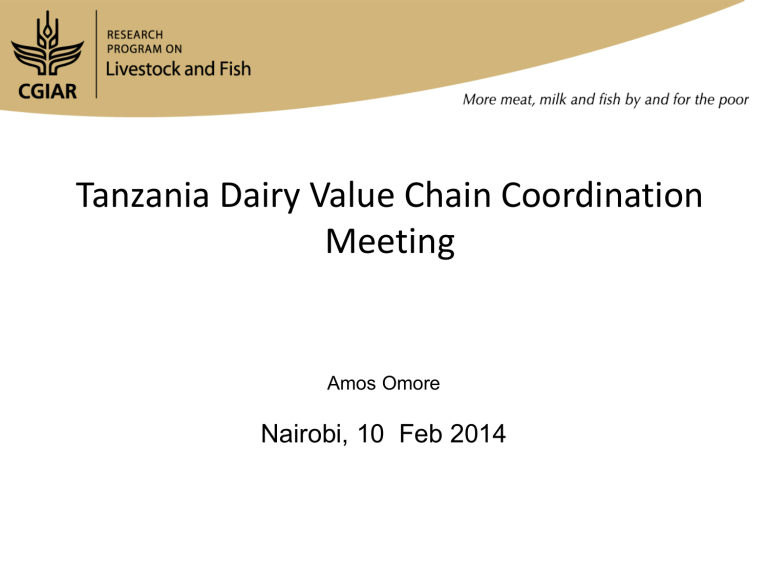
Tanzania Dairy Value Chain Coordination
Meeting
Amos Omore
Nairobi, 10 Feb 2014
Objectives
Based on a quick review of where we are now and what is planned: a) Share what will be done by who and when b) identify areas for synergies in implementation c) List outputs in 2014, with links to CRP outputs d) Develop a common work plan across activities
Big Picture: Place of LaF /A4HN R4D in ‘Maziwa Zaidi’
Time
Goal: More milk, income, assets and better health & nutrition thro’ a) access to quality inputs and services b) access to reliable, well-coordinated, marketing arrangement c) access to quality, safe and nutritious products at affordable prices
Scaling out development partnerships
(e.g., EADD2? + +)
Scaling out development partnerships (e.g.,
EADD2)
Research & piloting partnerships (e.g.,
MoreMilkiT, MilkiT; SFFF2; new proposals)
LaF/A4HN Strategic Research
10 years
Big Picture: Links to LaF VCD theme
2014 focus is on generation of evidence from targeted research and pilot of interventions
LaF Value Chain Development
L&F Generic outputs and implications for Tanz in 2014
VCD Outcome: Stakeholders are aware of and actively promoting pro-poor, gendersensitive strategies that are improving productivity and profitability, and increasing animal-source food consumption among poor consumers
Priority VCD Research outputs (with links to other LaF theme and A4HN outputs)
Implications for Tanzania / delivery mechanisms
1. Methods, models and tools for rapid VC assessment developed
2. “Best bets” piloted, validated and refined
3. Mechanisms for scaling up and out the successfully tested strategies for upgrading VC
Funded o Main: MoreMilkiT 2 (Irish Aid) o MilkIT – Feeds (IFAD) o SFFF 2 (BMZ); RIA (ACIAR) - FS o CGP– Gender (IDRC) o Cow Killer
Proposals submitted in 2013
• MoreMilkiT 2 (Irish Aid) - funded
• EADD2 - funded
• AgriTT - Genetics/SNP – funded
• SPIA – Waiting
• CultiAf – Food security/nutrition
Waiting
Pilot villages
List of Contributors to Tanzania Dairy 2013/14
ILRI
• Amos (VC coordination + AH &
Food safety+, CRP3.7/4.3)
• Isabelle, James (Irish Aid, SPIA)
• Silvia, Rosel, Delia, postdocs (Food safety, SFFF2)
• Brigitte, Ben, Fred, Alan (Feeds,
MilkIT)
• Julie, Okeyo, James (Breeding ,
DGEA)
• Silvia, Alice (Animal health, Cow
Killer, MoreMilkiT)
• Michael (Impact pathway)
• Alessandra (Gender through CGP,
MoreMilkiT)
• Salim (consultant, MoreMilkiT)
• Edgar Twine (MoreMilkiT)
• New staff (EADD2)
• Diana Iddo (CapDev)
Nat Research and Dev Partners
• SUA (IrishAid Project Coordinator)
• Heifer – Tanzania, FAIDA MaLi,
SNV(MoreMilkiT piloting)
• TALIRI & SUA –Tanga (MilkIT)
• Tanzania Dairy Board (MoreMilkiT)
• EADD2 partnerships
• MLDF, SNV, LoL, Private sector
(partners in DDF)
• Irish Researchers at Teagasc, UCD
(students, still exploring options)
• BfR – Germany; RVC (SFFF2)
• NUPI - Norway
• Students: SUA, Bonn, Nbi, Emory,
Queensland
More Milk in Tanzania (MoreMilkiT) Project
Outputs and Activities in 2014
More Milk in Tanzania (MoreMilkiT) Project
Plans to achieve objectives: 2013-16
1. Develop scalable value chains approaches with improved organization and institutions
• Output 1.1
Vibrant, well organized, and sustainable DMHs
delivering demand-led inputs and services developed (Led by
Heifer & Faida Mali)
– Establish DMHs:
– Operate the DMHs:
Targeting 30 villages with
4800 cattle keepers across 4 districts:
• Output 1.2
DMHs governance strategies strengthened
through non-formal trainings (Led by Heifer and FAIDA MaLi)
– Strengthening actors and their organisations
• Output 1.3
DMHs assessments undertaken and used for improving the performance of dairy value chains
– DMHs assessments (e.g., adapting and applying stage-gating tool) - serving development pilot in real-time
More Milk in Tanzania (MoreMilkiT) Project
Plans to achieve objectives: 2013-16
2. Generate and communicate evidence on business and organizational options
• Output 2.1
DMHs act as platforms for generating and communicating evidence on business and organisational options for increased participation of resource poor men and women in the dairy value chains
– Targeted research: serving development pilot in real-time
– Gender analysis and gender mainstreaming of DMHs
• Output 2.2
Value chain governance strategies strengthened to generate, package, and communicate information critical to DHMs rollout
– Improving quality assurance services and communication
• Output 2.3
Evidence of DMHs as viable and sustainable dairy value chain development models generated and communicated
– Assessment of the efficiency of integrating small-scale informal value chain into the formal and development of scaling out strategies
– Delivery of learning products - serving development pilot in real-time
More Milk in Tanzania (MoreMilkiT) Project
Plans to achieve objectives: 2013-16
3. Inform policy on appropriate role for pro-poor
smallholder-based informal sector value chains in dairy sector development
• Output 3.1
Lessons for sustainable value chain development through evidence-based research, monitoring and evaluation, and recommendations for scaling out developed and disseminated
– Generation and communication of evidence and lessons
– Advocacy
– Final evaluation
Cross-cutting Monitoring, Learning and Evaluation framework
More Milk in Tanzania (MoreMilkiT) Project
Piloting of adapted hubs to be main focus in
2013-16
Dairy Market Hubs (DMHs) with emphasis on improving access to inputs and services through business development services (BDS) and check-off arrangements:
a) DMHs revolving around chilling plants or accessing them (if under-utilized) through transport arrangements that provide both outputs marketing and inputs and services through check-offs;
b) DMHs revolving around check-offs for inputs and services provided through milk traders; and
c) DMHs revolving around check-offs for inputs and services provided through cattle traders.
Criteria for becoming a dairy market hub defined
DMH category a): Collective bulking and sale of milk by members of a farmers group b) and c): Individual members of a farmers group sell milk and/or cattle directly to traders
Criteria for becoming a DMH
Farmers group i) is registered at district level ii) has at least 1 link with a milk trader/ buyer and at least 1 link with an input & services provider iii) members are able to access inputs & services on check off system
Farmers group i) is registered at district level ii) members are able to access inputs & services on check off system
Hub for provision of inputs and services on credit without collective bulking and marketing
More Milk in Tanzania (MoreMilkiT) Project
Impact pathway and MLE framework developed
• Monitoring, learning and evaluation
(MLE) framework for pilot projects developed; 1 st monitoring survey soon
• Several targeted research activities and ex-ante assessment of interventions initiated, some through students
Baseline (benchmark) results available
• Most findings re-affirm VCA findings, with figures
• Commercialising the marginalised will mostly be about feed, less so other constraints!
DDF Update
It is evolving and continuing to catalyze policy dialogue for a pro-poor transformation of the dairy value chain…
MoreMilkIT Workplan for 2013/14
WORKPLAN: MoreMilkIT Year 2 Milestones
= completed = ongoing = pending
Qtr/Month/week in Yr 2
Activity Milestones
1
Qtr1
2 3 4
Qtr2
5 6 7
Qtr3
8 9 10
Qtr4
11 12
1 2 3 4 5 6 7 8 9 10 11 12 13 14 15 16 17 18 19 20 21 22 23 24 25 26 27 28 29 30 31 32 33 34 35 36 37 38 39 40 41 42 43 44 45 46 47 48
Objective 1: Develop scalable value chains approaches with improved organizations and institutions serving smallholder male and female households
Output 1.1 Vibrant, well organized, and sustainable DMHs delivering demand-led inputs developed
Performance
Indicators
1.1.1 Establish DMHs:
Initiate discussion son partnership arrangements with dev partners;
Recruit dev partner; agree DMH choices & villages; refine DMH constructs; identify constraints & responses to DMH introduction in villages
Establish initial batch of primary
DMHs
Mobilise cattle keepers to participate in
DMHs
5 DMHs; 900 members mobilised;
1.1.2 Operation of DMHs:
Des i gn proces s
& a cti vi ti es to empower DMHs
Operate DMHs Operate DMHs
7 BDS; 20 traders; vol of milk
Output 1.2 DMHs governance strategies strengthened through non-formal trainings
1.2.1 Strengthening actors and their organisations:
Conduct training & linkages needs assessments
Develop/adapt training materials
Conduct trainings and promote linkages for specified benefits
Training needs; 900 trained; # linkages made
Output 1.3 DMHs evaluations undertaken and used for improving the performance of dairy value chains.
Related
Costs
(Euros) Comments
Activities detailed under separate
Collaborative
Research
Agreements
78,464 (CRAs)
Heifer staff with SNV support
78,464 As above
Lead
Org
7,600
As Above. Activity initited in year 1
(activity 2.1)
SNV and
TDB
ILRI staff involved
AO, IB, JR, SN
Heifer with
SNV support AO, IB, JR, SN
AO
1.3.1 DMHs assessments to provide information for decision making
Conduct market assessments at
DMHs
Conduct ex-ante assessments of
DMH interventions
Ada pt s ta ge-ga ti ng tool for i ni ti a l s et of
DMHs
Lessons on DMH strengths & weaknesses
26,363 ILRI/SUA
IB, JR, DB, SN,
AN
Objective 2: Generate and communicate evidence on business and organizational options for increasing participation of resource poor men and women in dairy value chains
Output 2.1 DMHs established as platforms for generating and communicating evidence on business and organisational options for increased participation of resource poor men and women in the dairy value chains
2.1.1 Targeted research
Targeted research at DMHs depending on identified technical constraints; Innovation
Platforms in some
Targeted research at DMHs depending on identified technical constraints; Innovation
Platforms in some
2.1.2 Gender analysis and gender mainstreaming of DMHs
3.1.1 Generation and communication of evidence and lessons:
3.1.2 Advocacy
General administrative & coordination activities
Post-doc advert posted
Launch DDF
Design monitoring tools
Hold SC meeting (DDF
AC to play this role)
Des i gn communi ca ti on s tra tegy
Design advocacy strategy linked to project outputs progres s report
(+fi na nci a l
) & meeti ng wi th IA
Ana l ys e gender ba s ed cons tra i nts to pa ti ci pa ti on a nd benefi ts a t
DMHs
# gender studies
Output 2.2 Value chain governance strategies strengthened to generate, package, and communicate information critical to DHMs rollout
2.2.1 Improving quality assurance services and communication
Deta i l ed a cti vi ti es under ol l a bora ti ve Res ea rch Agreement (CRA) wi th TDB on i mprovi ng qua l i ty a s s ura nce a nd communi ca ti on i n the da i ry s ector i n Ta nza ni a , through Da i ry Devel opment Forum (DDF)a nd other cha nnel s
20 certified traders; 7 accredited BDS; # policy issues addressed by
DDF
Output 2.3 Evidence of DMHs as viable and sustainable dairy value chain development models generated and communicated
2.3.1 Assessment of the efficiency of integrating small-scale informal VC into the formal and dev of scaling out strategies
Des i gn tool s for a s s es s ment
Conduct 1s t round of a s s es s ment of i ntegra ti ng s ma l l -s ca l e/pre-commerci a l VC i nto the forma l / commerci a l
Objective 3: Inform policy on appropriate role for smallholder-based value chains in dairy sector development
Output 3.1 Lessons for sustainable VC development through evidence-based research, M&E, and recommendations for scaling out developed and disseminated
Key lessons; # feedback workshops
Share learnings at donor forum
National policy forum technical report
(+financial) & meeting with
IA
Workshops proceedings;
1 new investor
# meetings progress & SC meeting reports
Overhead
Total
3 functional IPs; # adoption studies
30,400
26,363
Activity initited in year 1 (activity
13,680 2.2) TDB
26,363
26,363
26,363
ILRI/SUA
ILRI/SUA
ILRI/SUA
ILRI/SUA
ILRI/SUA
ILRI/SUA
AO, IB, JR, SN,
SA, BL, AN, BL,
JO
AG, SN, all
AO, SN
JR, IB, HK, DB,
SN, AO, AN
IB, JR, AO, SN,
AN
AO, SN, all
AO, SN
59,574
400,000
Notes : ILRI Persons involved: AO=Amos Omore; IB=Isabelle Baltenweck, JR=James Rao; DB=Derek Baker, SN=Salim Nandonde, AG=Alessandra Galie; SA=Sylvia Alonso; HK=Hikuepi Katjiuongua; AN=Alice Njehu; BL=Ben Lukuyu; JO=Julie Ojango. Tanz/SUA
Persons involved: PC=Project Coordinator, value chain researchers & consultants. PC to help facilitate stakeholder engagements. Project has close linkage with IFAD MilkIT, BMZ SFFF . Project Coordinator (part-time, appointed by SUA) to be involved in all activities as per agreed ToRs, workplan and budget
MoreMilkIT Hubs Establishment Workplan Jan-Jun 2014
MoreMilkIT: Heifer WORKPLAN and MILESTONES - Updated 24-16 September 2013
= completed = ongoing
YEAR 2014
= pending
Activity Milestones
Qtr1 Qtr2
Heifer Indicators (Yr 1) Jan
25 26 27 28
Feb Mar Apr May Jun
30 31 32 33 34 35 36 37 38 39 40 41 42 43 44 45 46 47 48 29
Objective 1: Develop scalable value chains approaches with improved organizations and institutions serving smallholder male and female households
Output 1.1 Vibrant, well organized, and sustainable DMHs delivering demand-led inputs developed
Establish and Operate DMHs
Complementary SNV/TDB/ILRI roles
Comments
ILRI: Feedback with VC actors to validate results of rapid VC assessment and feedback on potential interventions
Acomplished by 25 Sep 2013 1.1. Awareness creation at village level (includes identification of loose interest groups and presenting results of the research at local level)
1.2. Facilitate/stimulate emergence of Interest Groups, by actor type (cattle keepers/milk vendor/SP) and identify the actor type that will be the pivot of the DMH (at least 20% of the villages reached by dec)
# meetings; # cattle keepers mobilised
1600 cattle keepers registered
1.3. Identify entry points for organising/emergence of interest groups
10 BDS; 30 traders; vol of milk
ILRI: develop tool; TDB: Assist to mobilize traders and BDS providers; FAIDA MaLi:
Conduct training needs assessments for emerging interest groups; validate the capacity building (CB) plan with each interest group/individuals to prioritize with them for ownership
1.4. Support training needs assesments for all interest groups and individual BDS (identify constraints, activities to engage, financial needs, market info needs, technical needs).
1.5. Participate in project review and planning meetings
1.6. Facilitate group formation / engage & strengthen existing groups (include dynamics, governance, constitution and registration)
CB plan, other needs e.g., more research
# meetings & recommendations
1600 cattle keepers in groups; 10 DMHs
ILRI: Convene project review and planning meetings
1.7. Implement business model(approach to address the constraints; include facilitation of emergency of business networks)
1.8. Facilitate the negotiation between different actors
1.9.Conduct training on dairy as a business (business attitude)
1.10. Support actors with market information on an on-going basis
10 BDS; 30 traders; vol of milk
1600 cattle keepers linked
1600 cattle keepers; 10
BDS; 30 traders; vol of milk
1600 cattle keepers; 10
BDS; 30 traders; vol of milk
FAIDA MaLi: Develop appropriate business models (approaches to address identified constraints and facilitate emergence of business networks); TDB: Complementary training and certification
FAIDA MaLi: Development of business plans for BDS providers (linked to Agri-hub
Tanzania incubation program) to inform training on diary as a business: TDB: Complementary training and certification
Target hanging fruits, do one round, then another of business linkages across all districts
FAIDA MaLi: Make follow-up visits to concretize deals and organize service delivery systems
Draws from VC info from the research, platforms, sharing etc
TDB: Provide manuals on quality assurance
Draws from info from research, platforms, sharing etc; use training materials from Heifer and TDB for on-farm targeted coaching etc.
1.11. Support actors with technical information
1.12. Facilitate knowledge sharing exhibition, exchange visits (business and technical needs)
1600 cattle keepers;
# reps of 1600 cattle keepers;
1.13. Support actors to link with financial institutions (VICOBA, Banks, SACCOS etc--). Based on business plans of different actor (s)
Output 1.2 DMHs governance strategies strengthened through non-formal trainings
1600 cattle keepers; 10
BDS; 30 traders; vol of milk
FAIDA MaLi: Facilitate the negotiation between the different actors through business-tobusiness (B2B) forums/workshops to reinforce training on diary as a business.
2.1 Facilitate linkages between village-level feed innovations platforms, other DMHs and
T AMPRODA
2.2. Link DMHs with Agri-hub T Z and DDF initiatives on communication
1600 cattle keepers linked
10 DMHs linked
SNV: Strengtheni ng TAMPRODA governa nce a nd communi ty-l evel to s upport emergi ng DMHs (l i nked to emergi ng Feed Innova ti on
Pl a tforms )
SNV : Strengthen DDF Secreta ri a t’s ca pa ci ty on communi ca ti on, l i nked to Agri -hub Ta nza ni a
Overall Tanz VC Workplan for 2014
Gannt Chart for coordination & communication
Tanzania VC Workplan 2014
Output Milestone Activity
Qtr 1
1
Timelines: Quarter/Month
Qtr 2 Qtr 3 Qtr 4
2 3 4 1 2 3 4 1 2 3 4 1 2 3 4
MoreMilkiT MilkIT
Project delivering output milestone and persons involved
L&F/A4HN related projects
SFFF2
What kills my cow
CGP EADD2 DGEA
CG funds / other
1. Methods and tools developed and applied to identify potential interventions for improved VC performance
1. Methods, models and tools for VC assessment developed, pre-tested and adopted by "Date"
2. VC assessments completed for the target VCs by "Date"
3. Potential interventions at scale for improved VC performance identified and prioritised by "Date"
Conduct situational analysis
Collect secondary data for sectorial and policy models
Finalisation of VC assessment tools:
• Collect feedback on research questions and tools (email)
• Workshop to finalise research questions, indicators, tools
Develop review process for methods, tools and models
Conduct rapid VC assessments
Feedback workshops with VC actors to validate results of rapid VC assessment and for feedback on potential interventions
Conduct in-depth analysis in VCs (probing on specific constraints / interventions) ... possibly combined with baseline
Feedback to VC actors to validate results of in-depth VC assessment and for feedback on potential interventions
Review of best practices and successful / failures related to pro-poor development of target value chains
Define process to prioritize interventions (ex ante) / ( participatory with target users and other VC actors)
Package the prioritized integrated intervention strategies
Write proposal(s) with partners; based on VC assessment and potential interventions
A series of feedback workshops with ALL the VC actors & stakeholders --> on the results of the VC assessment done in phase 1& the proposed best bets
2. “Best bets” piloted, validated and refined, also other new technical and institutional solutions, with partners and other value actors.
1. Partners, activities, and pilot locations agreed for “X” VCs through broad stakeholder consultations
2. At least “X” VC interventions piloted and evaluated
3. Refinement of “best bets” & preparation of options for scaling across VCs by “Date”
3. Mechanisms for scaling up and out the successfully tested strategies for upgrading
VC; CRP L&F documented influence that is fostering implementation at scale supported by an enabling environment
1. Innovation system tested
2. Policy environment enhanced
Identify partners for implementation - based on suggestions from the feedback workshops
Identify sites for implementation - based on consultations with proposed implementation partners
Design the proposed M&E framework for the implementation (based on the selected partners, sites, and intervention)
Prepare proposal to secure resources & funding (incl from implementation partners) to implement - based on the outcomes of the feedback workshops
Engage with partners (including beneficiaries) and agree on the modalities for implementation
Capacity Development of partners (including Capacity Needs Assessment, Develop / Adapt training tools / Carry out training)
“The actual thing” – pilots taking place
Implement the M&E plan
Dissemination and communication activities with partners (ongoing)
Synthesis of the evaluations / pilots (within countries / VCs)
Identification of potential for scale (synthesis across VC and geographies)
(implied or explicit activity ?) : go back and rework tools/interventions based on pilots
Workshops (after/during each stage) to validate and refine “best bets”
Dissemination and communication activities (at all levels of the VC)
Conceptual framework for Platforms and multi stakeholder processes defined
Platforms formed in all target areas with issues and actors defined, to form the basis of alliances
Platform generated evidence and platform processes are documented, tested, shared and analysed.
Alliances formed to build on and exploit learning to take processes to scale
Informing value chain processes through robust knowledge services
Methods and tools for effective policy engagement defined
Policy review conducted on key policies in each target area
Monitoring policy actions that have happened
DG, KR, SA
DG, KR, SA
DG, KR, SA
DG, KR, SA
DG, KR, SA
DG, KR, SA
DG, KR, SA
Persons involved: AO=Amos Omore; IB=Isabelle Baltenweck, DB=Derek Baker, HK= Hikuepi (Epi) Katjiuongua; MK=Michael Kidoido; AN=Alice Njehu; JP=Jane Poole; BL=Ben Lukuyu; DG=Delia Grace; KR=Kristina Rosel; OM=Okeyo Mwai; PT=Phil Toye; BLM=Brigitte Maass; MF=Mohamadou Fadiga; KC=Cathy Colvorson, SW; Stuart Worsley; KR=Kar Rich, Post-doc;
SA=Silvia Alonso
Activities not aligned to the above outputs (if any) / events
MoreMilkiT
MilkIT
SFFF
What kills my cow
CGP
EADD2
DGEA
AgriTT/SNP?
???
DDF 6 Feb; EXTRAPOLATE Workshop 4-6 Mar; Visit with IA consultants 10-14 Mar; MoremilkiT/MilkIT Review/SC 16-18 Mar; ILRI Dar office opening 21 Mar
Disease diagnostics for a range of animal health and public health hazards. Feedback on results for extention services and (possibly) farmers
